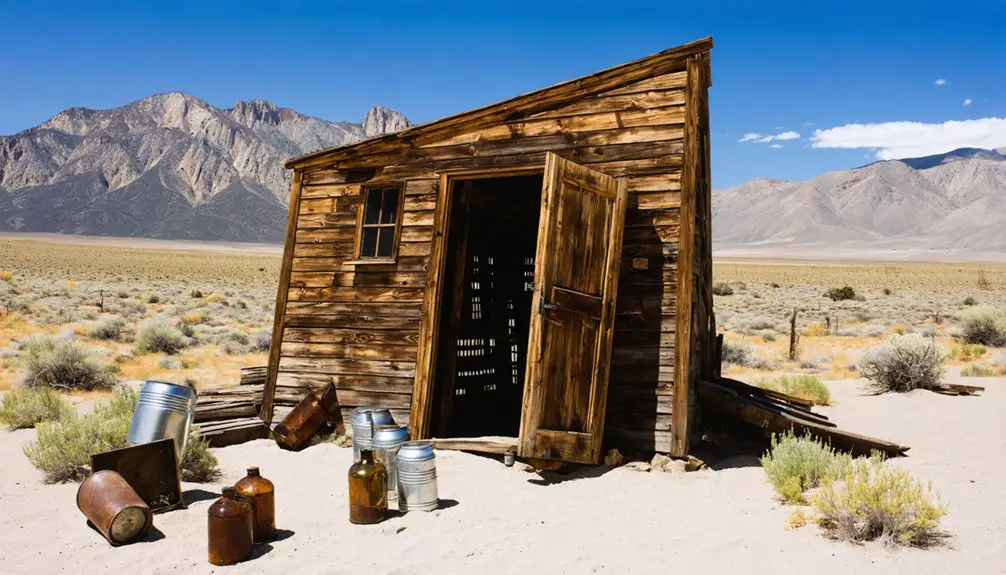You’ll find Silver Peak nestled in Nevada’s high desert, where rich silver deposits discovered in 1863 sparked a mining boom that’s never truly ended. The town’s adobe buildings, stone ruins, and abandoned mines tell stories of over 5 million ounces of silver production, while modern lithium operations keep it from becoming a complete ghost town. From the 1865 stamp mill to today’s solar evaporation pools, Silver Peak’s legacy spans generations of mineral extraction.
Key Takeaways
- Silver Peak, founded in 1863 after silver discoveries, is one of Nevada’s oldest mining towns still inhabited despite its ghost town status.
- The town produced over 5 million ounces of silver and 300,000 troy ounces of gold between the 1870s and 1986.
- Blair Township, a nearby ghost town connected by rail, boomed with 700 residents before completely declining by 1920.
- Historical structures, including stone buildings from early mining eras and abandoned mining claims, remain visible throughout Silver Peak.
- The town continues operating as America’s only lithium production site since 1966, maintaining a small population amid historic ruins.
The Birth of a Silver Boomtown (1864-1870)
When prospectors from Austin and Big Smokey Valley discovered rich silver deposits in 1863, they set in motion the birth of one of Nevada’s oldest mining communities. By 1864, they’d established Silver Peak near a vital spring, building a settlement that’d support their ambitious mining ventures. Adobe buildings were constructed in 1865 to house the growing population of miners and workers.
The town’s rapid growth brought both progress and challenges. A 10-stamp mill in 1865, expanded to 20 stamps by 1867, marked Silver Peak’s industrial evolution. Located in the eastern part of the Silver Peak Range, the mining district would become known for its rich mineral deposits.
Yet mining folklore tells of the era’s wild nature, with tales like Fred Vollmer Sr.’s infamous poker loss highlighting the frontier’s unpredictable spirit. Despite lawlessness and operational hurdles, community resilience shone through as the settlement weathered its initial boom years.
Though major operations ceased by 1870, Silver Peak’s early foundations would support future mining revivals for generations to come.
Early Mining Infrastructure and Development
You’ll find Silver Peak‘s first significant processing facility in its 1865 ten-stamp mill, which quickly expanded to include a twenty-stamp operation by 1867.
The district’s infrastructure took a revolutionary leap with John Chiatovich’s 1893 cyanide mill, one of the first in the nation, improving precious metal recovery from low-grade ores. The mill successfully processed 45 tons per day during its peak operations.
The arrival of the Silver Peak Railroad in 1906 connected the massive 100-stamp Blair mill to the mines, transforming the region into Nevada’s largest ore processing center of its time. Operations at this impressive facility continued until Foote Mineral Company revived the area in 1966 with a lithium brine operation.
First Mills and Operations
The early mining infrastructure at Silver Peak rapidly evolved to meet the demands of ore processing, beginning with the construction of a 10-stamp mill in 1865.
You’ll find evidence of swift expansion in the area’s early milling capabilities, as within just two years, a larger 20-stamp mill was crushing ore from the surrounding mines.
The most significant advancement in mining techniques came when John Chiatovich constructed one of America’s first cyanide mills in 1893.
This pioneering facility revolutionized how miners extracted precious metals from the ore.
Despite these technological improvements, mining operations remained sporadic throughout the late 1800s, with various companies and lessees attempting to make their fortune.
The frequent changes in mill ownership and technology during this period reflected the challenging nature of sustaining profitable operations in this rugged frontier environment.
High land prices in Silver Peak eventually led to the establishment of the town of Blair with its own stamp mill.
Railroad Impact and Growth
As mining operations expanded beyond the initial mills, Silver Peak’s infrastructure took a significant leap forward with the arrival of the Silver Peak Railroad in 1906.
You’ll find that this 17.5-mile rail line, built by Pittsburgh Silver Peak Gold Mining Company, transformed mining logistics by connecting Blair Junction to the town of Blair.
The railroad’s impact went far beyond ore transportation. You can trace how it sparked the region’s growth through Blair Junction’s development as a crucial hub, complete with a depot and water station. The Italian brothers operated a lucrative firewood shipping business from Wood Yard station, located eight miles south of the junction.
The railroad supported daily passenger service using McKeen motor cars, while enabling efficient transport of supplies and firewood.
When mining activities flourished, you’d have seen constant movement of ore shipments to Blair’s 100-stamp mill, making the railroad the lifeline of Silver Peak’s mining economy. After mining operations declined, the railroad infrastructure was dismantled in 1918, marking the end of an era for Silver Peak’s rail transportation.
Mining Equipment Advances
Mining innovation in Silver Peak began modestly with a 10-stamp mill in 1865, marking the town’s first major step in ore processing infrastructure.
You’ll find that within two years, mining technology advanced to a 20-stamp operation, boosting the town’s ability to process precious metals from raw ore.
The real equipment evolution came in 1907 when the Pittsburg-Silver Peak Gold Mining Company revolutionized local mining with Nevada’s largest mill – a 100-stamp facility incorporating cutting-edge cyanide processing.
This technological leap allowed miners to extract value from previously worthless low-grade ore.
While early operations struggled with water access and equipment limitations, this massive upgrade represented Silver Peak’s golden age of mining technology.
The site’s evolution didn’t stop there – by the 1960s, you’d see an entirely new era emerge as lithium extraction equipment replaced traditional stamp mills.
Today’s operations continue to evolve with solar evaporation ponds that concentrate lithium salts over an 18-24 month period.
The Rise and Fall of Blair Township
Founded in 1906 by the Pittsburgh Silver Peak Gold Mining Company, Blair emerged as a strategically planned settlement three miles north of Silver Peak, Nevada. Land values in the area skyrocketed as eager speculators drove up prices.
The Blair community quickly grew around one of Nevada’s largest stamp mills, processing over $6 million in gold ore through its 100-120 stamps. Patty Flannery established a popular saloon and hotel that featured a basement brewery. You’ll find the mining heritage reflected in the town’s sophisticated infrastructure, including a 14,000-foot aerial tramway and a 17.5-mile railroad connection to the main line.
At its peak, Blair bustled with 700 residents, a two-story hotel, saloons, and a Chinese laundry.
Picture Blair in its heyday: streets alive with 700 souls, the hotel rising two stories high, saloons humming, laundry steam rising.
But by 1915, low-grade ore made operations unprofitable. The mill’s closure in 1917 triggered Blair’s rapid decline, and by 1920, the town stood nearly abandoned.
Today, only stone foundations and mill ruins remain, silent testimonies to Blair’s brief but prosperous existence.
Notable Mining Operations and Production
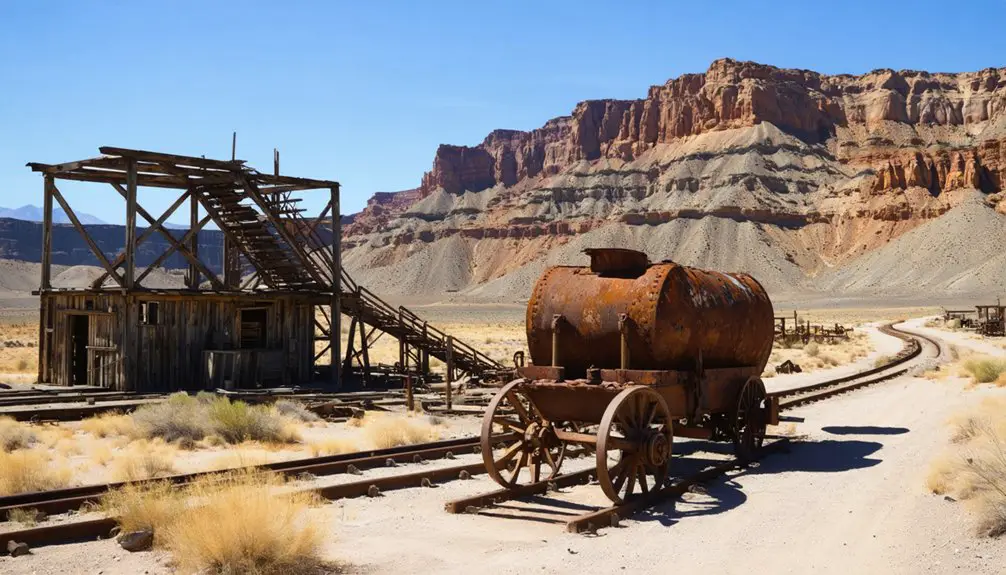
You’ll find Silver Peak’s historic mining landscape dominated by remnants of its prolific silver operations, including the massive 100-stamp Blair mill that processed low-grade ore from 1907 to 1915.
The district’s evolution is marked by three distinct periods: early small-scale mining from 1863, the Pittsburg-Silver Peak Gold Mining Company’s large-scale operations in the early 1900s, and today’s lithium brine extraction which began in 1966.
What makes Silver Peak unique is its continuous mining heritage, shifting from precious metals to becoming America’s only major lithium brine operation.
Historic Silver Production Era
The rich mineral wealth of Silver Peak’s mining district yielded impressive production numbers throughout its operational history, with total output exceeding 5 million ounces of silver and 300,000 troy ounces of gold from the 1870s through 1986.
You’ll find mining legends surrounding early operations, where silver discoveries led to the construction of stamp mills – first a 10-stamp in 1865, followed by a 20-stamp mill in 1867.
Two operations stand out in particular: the Nivloc Mine, which produced 4.7 million ounces of silver between 1937-1943, and the 16-to-1 Mine, yielding 5 million ounces during the 1980s.
At its peak, the 16-to-1 processed 800 tons of ore daily through cyanide vat leaching before closing due to falling metal prices.
Modern Lithium Mining Impact
Since 1966, Silver Peak has transformed from a historic silver mining town into America’s sole domestic lithium production site, where Albemarle U.S., Inc. extracts this essential mineral through solar evaporation of lithium-rich brines.
While producing over 5,500 metric tons of lithium carbonate annually, this operation has reshaped the local economy and landscape.
The facility’s environmental impact includes significant water usage in the arid Great Basin, yet its solar evaporation process offers advantages over traditional hard rock mining.
- You’ll find massive evaporation ponds stretching across Clayton Valley
- The operation provides critical lithium for EV batteries and defense materials
- Local water resources face increasing pressure from mining activities
- The facility represents less than 2% of global lithium production
- Nevada’s abundant sunshine makes solar evaporation mining possible year-round
Notable Mining Site Features
Mining operations at Silver Peak showcase a rich history of technological evolution and production milestones spanning over 150 years.
As you explore this ghost town’s mining legacy, you’ll find the remnants of innovative milling operations, from the early 10-stamp mill built in 1865 to John Chiatovich’s groundbreaking cyanide mill constructed in 1893 – one of the nation’s first.
The most impressive site was the 100-stamp cyanide mill at Blair, constructed in 1907 as Nevada’s largest mill of its time.
You can still trace the old Silver Peak Railroad line that served it.
In the Red Mountain area, you’ll discover the historic Mohawk Mine, which sits at nearly 9,000 feet elevation.
The district’s numerous mines, including the Drinkwater, Mary, and Alpine claims, represent the evolution from small-scale to industrial-scale mining operations.
Cycles of Prosperity and Decline
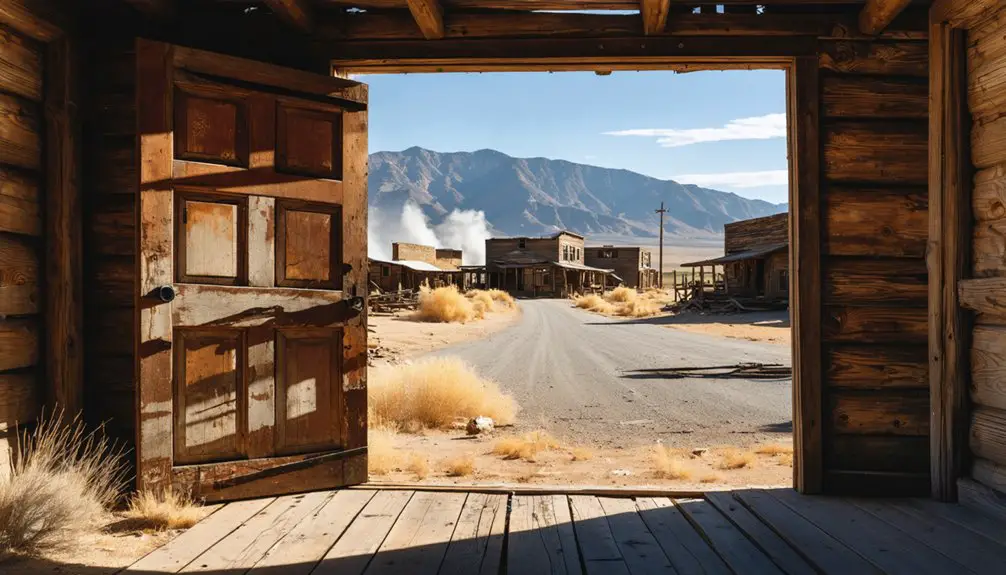
Located in one of Nevada’s oldest mining districts, Silver Peak exemplifies the classic boom-bust pattern of Western frontier towns. The town’s mining economics have swung dramatically since its 1864 founding, demonstrating remarkable community resilience through multiple cycles of prosperity and decline.
- You’ll find evidence of the first boom in 1865-1867 with the construction of early stamp mills.
- The largest surge came in 1906 when the 100-stamp cyanide mill at Blair made Silver Peak a top producer.
- A 1928 revival brought the population to 1,200 before another decline.
- The devastating 1948 fire nearly wiped out the town, leaving just 59 residents by 1950.
- Since 1966, lithium extraction has created a new era of stability, proving Silver Peak’s adaptability to changing mineral markets.
The Tragic Story of Mohawk Mine
Among Silver Peak’s most poignant chapters stands the story of Mohawk Mine, where hope and tragedy intertwined in the rugged Silver Peak Range.
You’ll find its legacy etched in both silver and sorrow, beginning with its 1920 discovery and culminating in the heartbreaking events of 1959.
The mine flourished in the 1950s when Avery Brundage’s vision transformed it into a modern operation with a 100-ton mill.
Avery Brundage brought the Mohawk Mine into the modern era, installing a mighty 100-ton mill that heralded its golden age.
But fate struck cruelly in October 1959, when a catastrophic shaft collapse trapped three miners, including Louis Shirley, brother of the mine’s discoverer.
Despite nationwide rescue efforts, they remain forever sealed within the mountain.
Today, at 8,200 feet elevation, the silent mine buildings stand as a memorial to this miner legacy, reminding visitors of both the promise and peril of Nevada’s mining frontier.
From Silver Rush to Lithium Boom
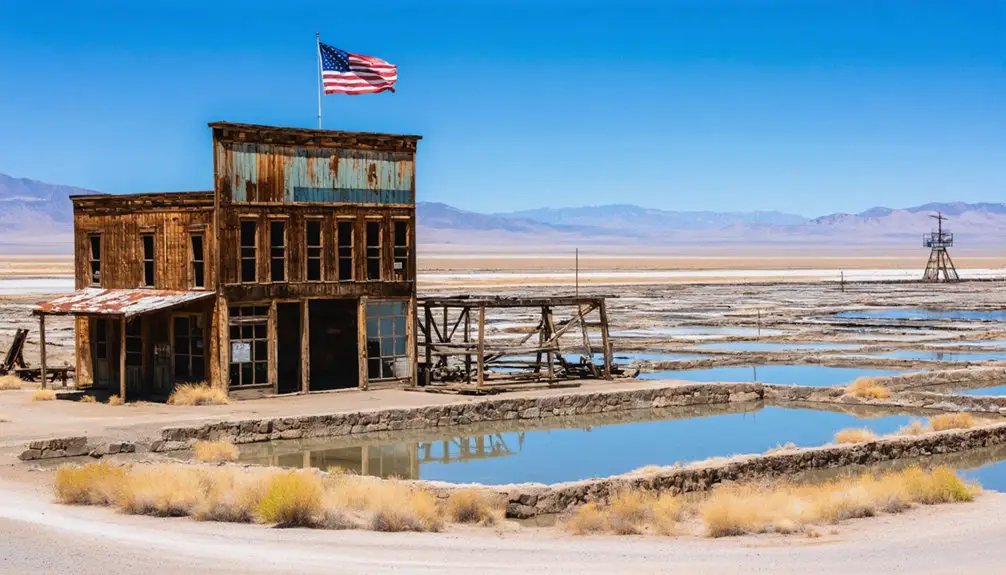
You’ll find Silver Peak’s journey marked by the challenging fluctuations of its early silver mining days, from the 1865 installation of a modest 10-stamp mill to the ambitious 100-stamp cyanide operation at Blair in 1906.
The town’s fortunes mirrored these technological shifts, experiencing both rapid growth and devastating decline until the 1948 fire nearly erased its mining heritage.
The discovery of lithium brine deposits in 1966 transformed Silver Peak from a fading ghost town into America’s sole lithium producer, showcasing how modern mineral demands can breathe new life into historic mining communities.
Early Mining Challenges
When silver was discovered in 1863, Silver Peak‘s early miners faced a complex web of challenges that would shape the town’s volatile future.
You’ll find that early mining struggles defined the settlement’s character, from the modest beginnings of a 10-stamp mill in 1865 to ambitious expansions.
The region’s lawlessness issues created an unstable environment that persisted for decades, testing the resolve of those seeking their fortune.
- Water scarcity drove settlers to establish the town near a significant spring
- Initial milling operations fought technical limitations with varying success
- Ownership changes disrupted consistent mining development
- Early attempts at innovation, like Chiatovich’s 1893 cyanide mill, showed promise but faced setbacks
- Intermittent mining activity reflected the boom-and-bust nature of frontier operations
Modern Lithium Production Evolution
The discovery of rich lithium deposits beneath Clayton Valley transformed Silver Peak from a declining silver town into America’s first lithium production hub in 1966.
When Foote Mineral Company pioneered lithium extraction from the valley’s subsurface brines, you’d witness a revolutionary change in mining focus. The operation, now run by Albemarle Corporation, produces 5,512 tons of lithium carbonate annually through brine evaporation techniques.
Unlike the boom-and-bust cycle of silver mining, lithium production has provided steady economic stability.
You’ll find that the town’s mining infrastructure adapted seamlessly from processing precious metals to extracting critical battery materials. This shift perfectly captured the evolving demands of the global mineral market, with lithium consumption expected to reach 95% battery use by 2030.
Preserving Historical Mining Heritage
Since its settlement in 1864, Silver Peak‘s rich mining heritage has endured through scattered remnants and deteriorating structures that tell a compelling story of Nevada’s mineral wealth.
Today, you’ll find preservation challenges throughout the site, from collapsed mine shafts to weathered bunkhouses, yet these remnants offer invaluable insights into Western mining history.
Silver Peak’s decaying structures and mining remnants stand as silent witnesses, preserving crucial chapters of the American West’s industrial heritage.
- The historic Mohawk Mine camp, though remote, provides archaeological evidence of mining life.
- Original stamp mill foundations from 1865-1867 showcase early ore processing technology.
- Surface scarring and tailings piles mark the landscape, revealing mining operation patterns.
- Abandoned equipment and structural remains tell stories of boom-and-bust cycles.
- The Silver Peak Railroad and 100-stamp mill ruins demonstrate early 1900s industrial scale.
Mining companies now balance modern operations with heritage preservation, ensuring these physical connections to Nevada’s past survive for future generations to explore.
Getting to Silver Peak Today
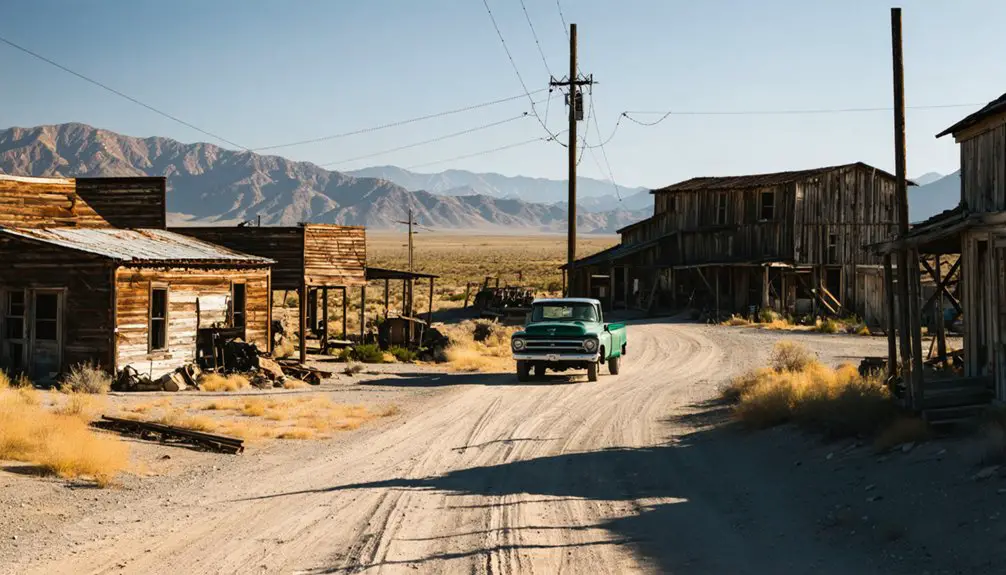
Modern travelers can reach Silver Peak via two main routes that connect this historic mining site to Nevada’s highway system.
The primary access route is paved Nevada State Route 265, which you’ll find at Blair Junction about 34 miles west of Tonopah on US Routes 6/95.
Alternatively, you can take Silver Peak Road from US-95 just north of Goldfield, though only the first 7 miles are paved.
Road conditions vary considerably beyond the main paved arteries. While SR-265 accommodates standard vehicles year-round, you’ll want to verify conditions for any off-pavement exploration.
When visiting, remember that many historic structures and mining areas sit on private property. You can navigate using GPS coordinates (37.755 N, -117.635 W), but respect posted signs and property boundaries.
Living Ghost Town Experience
While many ghost towns exist as mere relics of Nevada’s past, Silver Peak defies simple categorization through its unique blend of abandonment and liveliness.
You’ll witness community resilience in action as residents navigate life between weathered historical structures and modern lithium operations. The mining legacy lives on through both abandoned claims and active extraction, creating an authentic atmosphere where past meets present.
- Spot active signs of life including trailer homes, cars, and an operating ambulance
- Explore streets lined with historical artifacts and stone buildings from early mining eras
- Experience the contrast between industrial lithium pools and ghost town ruins
- Notice religious diversity through the welcoming LDS church presence
- Discover preserved elements like decorative floors and wood-burning fireplaces in abandoned structures
Frequently Asked Questions
What Was the Average Salary of Miners in Silver Peak During 1864-1870?
You’d have earned around $70 per month plus board as a white miner in the historical economy of 1864-1870, though mining wages varied based on your ethnicity and specific job duties.
Are There Any Documented Paranormal Activities in Silver Peak’s Abandoned Buildings?
While 80% of Nevada ghost towns report paranormal activity, you won’t find officially documented ghost sightings or haunted buildings in Silver Peak, though neighboring mining towns have verified spectral encounters.
What Happened to the Original Mining Equipment From the First Stamp Mills?
You’ll find most of the original mining equipment from those first stamp mills was either moved to Palmetto in 1868, scrapped during ownership changes, or repurposed as operations modernized with cyanide processing.
Which Native American Tribes Inhabited the Silver Peak Area Before Mining?
As luck would have it, the Northern Paiute and Washoe tribes called this area home before mining began. Though they weren’t part of Navajo history, their Paiute culture thrived through hunting and gathering.
How Many Original Structures From the 1860S Still Exist in Silver Peak?
You won’t find any original buildings from the 1860s in the area today. Historical preservation efforts have documented that fires, especially the major 1948 blaze, destroyed the earliest structures.
References
- https://erikjengh.wordpress.com/2016/07/07/silver-peak-nv-a-living-ghost-town/
- https://shpo.nv.gov/nevadas-historical-markers/historical-markers/silver-peak
- https://www.wilddeathvalley.com/mohawk-mine-silver-peak-district-a-site-of/
- https://www.nvexpeditions.com/esmeralda/silverpeak.php
- https://www.atlasobscura.com/places/silver-peak
- https://westernmininghistory.com/towns/nevada/silver-peak/
- https://nevadamining.org/new-history-page/
- https://en.wikipedia.org/wiki/Silver_Peak_Railroad
- https://www.nvexpeditions.com/esmeralda/blairjct.php
- https://mckeencar.com/gallery/s/silver-peak-railroad/
